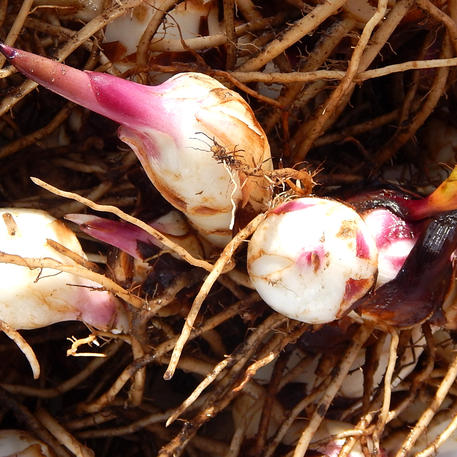-
Filter By Stock
- In Stock (0)
ARROWROOT
BOTANICAL NAME: Canna edulis
FAMILY: Cannaceae
ORIGIN: originated in the Andean region or Peruvian coast and extended from Venezuela to northern Chile, in South America.
PLANT DESCRIPTION
Perennial. Very hardy, clumping plant to 3m high with thick stalks and large bright green leaves up to 60cm long.
The tubers have a high potassium content and contain up to 3% protein; the young leaves and shoots and are also edible and contain up to 10% protein.
GROWING TIPS
Requires a warm sunny position with growth slower in cooler areas. Suitable for temperate, subtropical and tropical areas.
It grows best in areas where annual daytime temperatures are within the range 20 - 30°C, but can tolerate 9 - 32°C. The top growth tolerates light frosts and plants can be grown in areas with winter snow. Mature top growth can be killed by temperatures of -2°C or lower, whilst fresh young growth is severely damaged at 0°C. Requires a deep rich well-drained soil in a sunny position. Tolerates heavy soils. Requires ample water in the growing season. The root can be harvested within 6 months from planting out, though larger yields are obtained after 8 - 10 months. Plants are rarely troubled by pests or diseases.
USES
Food: The tubers are best harvested to eat when still small, about the size of a tennis ball and the skin is still white. They can be used all year round, as a potato substitute. Peel the tubers and cut them into chips, then bake in the oven until golden brown. Serve with a dash of butter and a sprinkle of salt. In Peru the roots are baked for up to 12 hours by which time they become a white, translucent, fibrous and somewhat mucilaginous mass with a sweetish taste.
Tubers may also be added to soups, or steamed like potatoes, until tender. Young tubers have the best flavour, older ones are fibrous.
To make arrowroot flour peel the tubers and cut into 2cm cubes and blend with water to a pulp. Tip pulp into a large bowl and add water. The flour will quickly settle to the bottom and the brown fibrous pulp can be drained off the top. Continue to rinse until the water runs clear. Drain off the water and pour the white flour into trays, 1-2 cm thick. Dry in the sun or dehydrator until soft and powdery. The flour keeps well and can be used as a thickener.
Young shoots may be cooked and eaten as a green vegetable resulting in a sweet but fibrous dish.
Animal Fodder: Leaves are useful as fodder for goats, cows and horses; tubers may be cooked and used as feed for pigs.
Garden Mulch: The leaves of the arrowroot plant provides an excellent on-going source of mulch, or can be used as a weed barrier and low windbreak in the garden.
In the Laundry: The starch from the roots is sometimes used as a laundry starch
PLANTING GUIDE
Recommended Planting Time: All year.
Planting Depth: Cover tubers with soil.
Spacing: Space tubers 30 cm apart, divide after several months if more plants are required.
Propagation: Division of the root clump as the plant comes into growth. Each portion must have at least one growing point.
COMPANION PLANTS
Arrowroot is a great companion for most other crops. It is a good weed/grass barrier and, if mulched into the soil at the end of the growing season, a good source of calcium for other plants.

ARROWROOT (Pack of 2)
***NOT TO TAS, SA, WA*** (Canna indica) Heirloom originally from South America and one of the ancient Incan foods. Also known as 'Achira'. Very ve
$14.95
